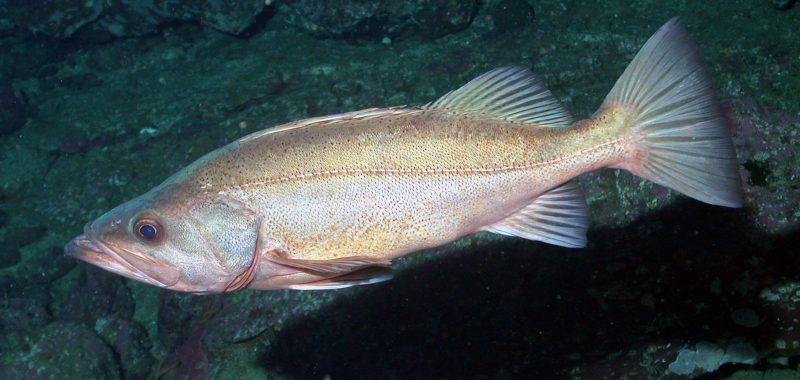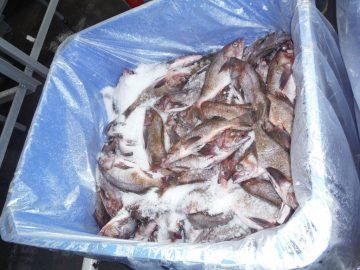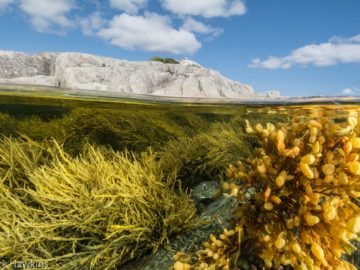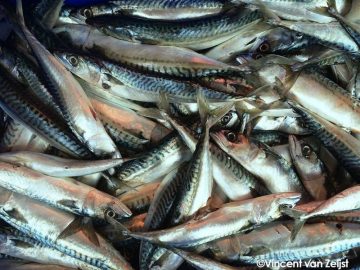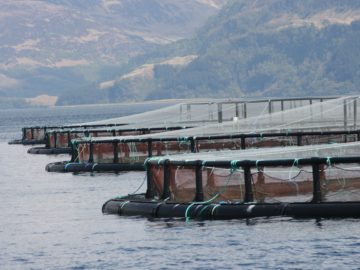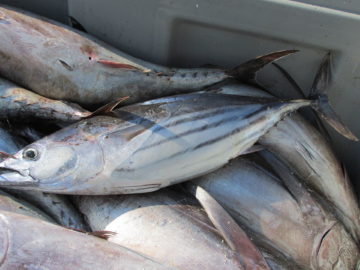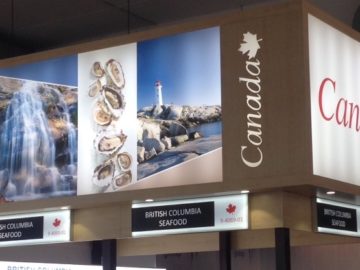By Scott Wallace, Senior Research Scientist at the David Suzuki Foundation and SeaChoice Steering Committee member
After years of careful management and industry efforts, bocaccio rockfish are rebounding
Nobody likes a big mouth. Well, that’s not completely true. Canada’s Pacific groundfish industry is elated about a long hoped-for recovery of bocaccio rockfish. Bocaccio derive their name from the Italian term ‘bocacho’ meaning big-mouthed. While very few people have heard of this fish species, it has been the most talked about species in British Columbia’s groundfish fishery for the last 18 years.
Rockfish fisheries are difficult to manage. There are 39 species of rockfish in our waters and they all have an inherent vulnerability to over-harvesting and a highly variable survival rate. The amazing story of bocaccio’s sudden recovery carries lessons that can be applied to most fisheries. It underlines the importance of having patience, managing expectations and building enough resilience to be able to follow nature’s lead.
Since the 1950s, bocaccio populations from southern California to Alaska experienced a sustained decline throughout their range (Figure 1). In Canada’s Pacific waters, it is estimated that the population has declined to 3.5% of its unfished level. The situation was so severe that in 2002 the Committee on the Status of Endangered Wildlife in Canada (COSEWIC) recognized the species as threatened. Despite drastically lower catches and a prohibition on selling them, the bocaccio population continued to fall. In 2013, COSEWIC reassessed it as endangered – a more severe designation.
In Canada, the main rebuilding strategy has been to ratchet down the level of allowable bycatch and hope for a period of high recruitment (i.e., larval survival). Lowering the catch limit sounds easy, but the challenge with this species is that they are difficult to avoid while targeting other more abundant species of fish. Even if they are returned to the water right away, rockfish do not survive being caught with commercial fishing gear. The change in pressure affects them too much on their way to the surface. For 15 years, B.C.’s fishing fleets adapted their gear and methods to be able to stay within increasingly lower catch limits. That is, until 2019, when suddenly vessels were encountering bocaccio everywhere and could no longer avoid them. The hoped for high recruitment finally occurred.
Independent scientific surveys corroborated the information from fishers and indicated a population recovery. The recently published Science Advisory Report suggests that in 2016, larval survival was 44 times better than average (Figure 1). Three years later, the juveniles of this cohort became large enough to be captured by trawl nets. It’s not surprising that fishers started to exceed the restrictive catch quota.
For 2020, the quota for bocaccio has been cautiously increased, permitting industry a small level of non-directed catch while the population continues to grow (Figure 1). By 2022, a large portion of the 2016 cohort will become reproductively mature and will further contribute to rebuilding the population. Although marine ecosystems are highly unpredictable, at this point it appears that bocaccio is on a trajectory for recovery.
This explosive recovery was a result of rebuilding efforts, ocean environmental conditions and patience. And in addition to this being a much-needed good news story in these challenging times, the story of bocaccio illustrates an important lesson: it shows that the year-to-year stability which businesses and regulators prefer can be incompatible with a species’ life history strategy.
This means that for rockfish – and many other marine species – the only sustainable approach is to take a very small amount of what nature provides and accept that the “surplus” that we can safely harvest will change. We must be sure to leave enough resilience in the population until the next time when the ingredients of the ecosystem soup are favourable. For bocaccio, there was no predictable recovery trajectory, but all species have the capacity for resilience if we give them a chance. While it certainly was challenging, the industry had to accept lower levels of harvest and be patient while they waited for nature to provide the appropriate conditions for recovery.
Similar to most fished marine species, bocaccio are a product of an exceedingly complex marine ecosystem. Ensuring that all species are managed with conservative catch limits, accurate reporting, and an abundance of precaution are the most important elements of maintaining wild harvests into the future.
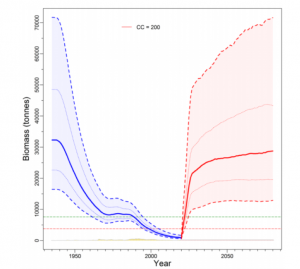
Figure 1: Estimates of spawning biomass (tonnes) from model published in Science Advisory Report. The median biomass trajectory appears as a solid curve surrounded by a 90% credibility envelope (quantiles: 0.05, 0.95) in light blue and delimited by dashed lines for years t=1935-2020; projected biomass appears in light red for years t=2021-2080. Also delimited is the 50% credibility interval (quantiles: 0.25-0.75) delimited by dotted lines. The horizontal dashed lines show the median Limit Reference Point (red: 0.4BMSY) and Upper Stock Reference point (green: 0.8BMSY). Catch and assumed catch policy (200 tonnes/year) are represented as bars along the bottom axis.
